



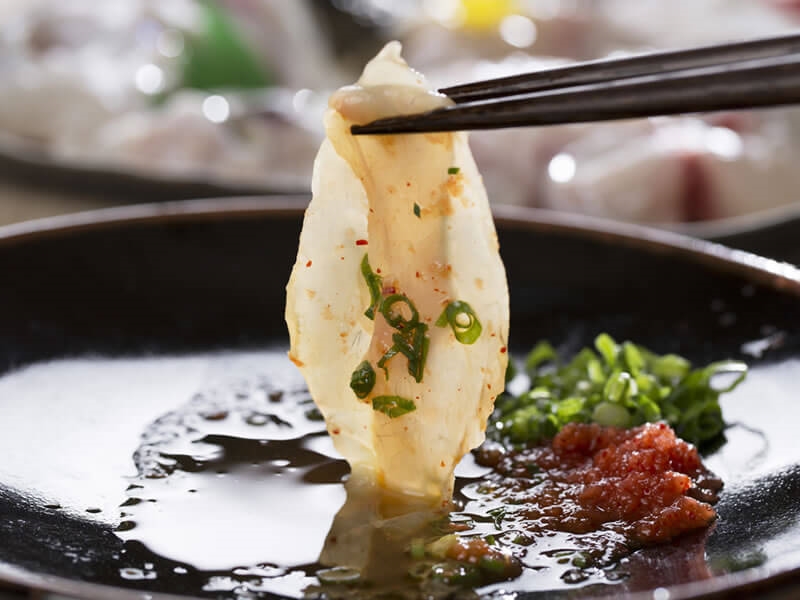
You like to eat ? If the answer to this question is yes (and it will be!), There are dishes that you must taste at least once in your life. From the most classic or the most original, we have selected 20 for you. Whether you love sweet or salty, there is something for everyone!
We start strong, with this venomous fish that the Japanese love. However, be careful, because if it is poorly prepared, it is assured death: his body contains tetrodotoxin, a deadly poison that causes respiratory arrest. Better to be sure of the cook when you consume it.
Moreover, in Japan, only restaurants that employ a carefully trained chef are allowed to use them . The method to apply? Throw the fish while still alive, being careful not to touch the liver, intestine and gonads (reproductive organs), since this is where the poison is. Once this operation is done delicately, its flesh is perfectly edible.
Most often presented in sashimi (its flesh, a little sweet, being fibrous, it is advisable to eat the fugu in thin slices), you will however have to put the price to taste it: a plate of sashimi can reach 60 euros.
Can also be eaten in soup ( chirinabe ), this famous fish even has its own day in Japan, February 9.
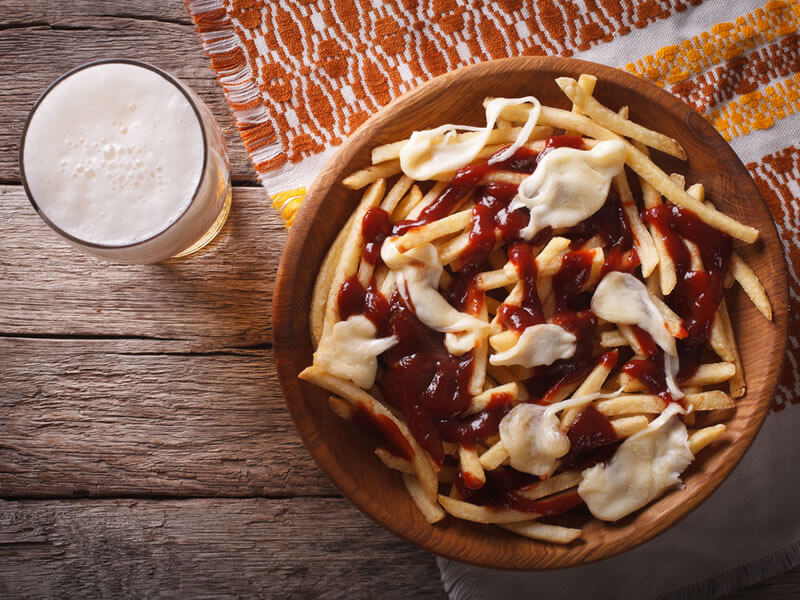 Crisp fries covered with fresh curd cheese and brown sauce (made from beef fat): it's THE must-have dish if you're in Quebec! A treat for your taste buds, and what to satisfy your stomach. On the other hand, it is your thighs that will thank you less, the poutine being a bomb caloric.
Crisp fries covered with fresh curd cheese and brown sauce (made from beef fat): it's THE must-have dish if you're in Quebec! A treat for your taste buds, and what to satisfy your stomach. On the other hand, it is your thighs that will thank you less, the poutine being a bomb caloric.
The cheese in grain, you know? In Canada, it is also called "skouik-skouik" cheese, because of the noise it makes when chewed. It is actually fresh cheddar cheese that has not been pressed.
Sometimes accompanied by minced meat or sausages (for those who have a great hunger), the poutine is as well served in the chip shops as foodtrucks, but also in fast food restaurants or restaurants (with foie gras in particular).
Originally from the Italian province of Reggio Emilia, the zabaione , which means "to foam" in an old regional dialect, was invented by Giovanni Baglioni, a captain who had ordered his soldiers to bring back food. These last incomes with a meager booty (eggs, honey, white wine and aromatic herbs), he hastened then to prepare a soup with these ingredients. Thus, and in a totally unforeseen way, was born sabayon!
Although her recipe seems simple, it does require some control : cooking the egg yolks beaten with the chosen alcohol requires attention because it is necessary for it to be carried out at low temperatures, without ever exceeding 65 °.
Now served all over the world, this sweet cream can also be prepared with Amaretto, Grand Marnier, or even champagne. Note that today sabayon is not consumed solely for dessert and is available in salty version. Thus, it is for example recommended to prepare it with champagne when accompanying oysters.
Crispy skin and soft flesh : these are the characteristics of this dish whose reputation is second to none. To achieve perfection, it requires careful preparation, but also a great experience from the chef who prepares it.
Once poultry plucked, an incision is made so that it can inject air that will allow the skin to peel off the flesh. She is then immersed in boiling water and dried. It is then that the lacquering stage intervenes: the latter is prepared with honey, soy sauce, rice wine and a mixture of spices. Once dry, the duck is then basted again and baked in an open brick oven.
Traditionally, duck is served in small wheat pancakes , which also includes pieces of cucumber and onion, and a brown sauce made from plum and soy sauce.
This dish appeared in the 15th century in the city of Nanjing, found acclaim three centuries later in Beijing, where the duck was so renowned for its quality.
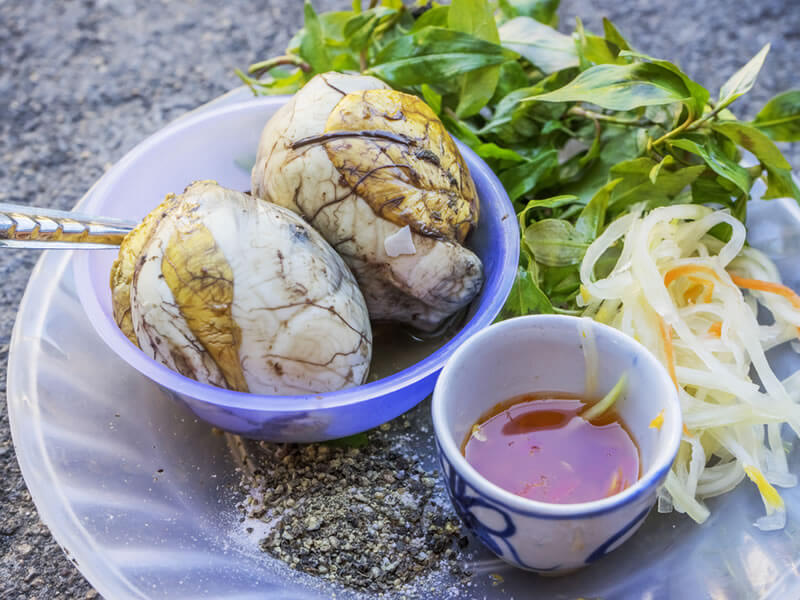 Sensitive souls abstain, only the most daring will dare to taste this specialty of Southeast Asia ... A fetus of duck, chicken, or duck . Clearly, an egg fertilized and incubated for 18 days, which is then boiled.
Sensitive souls abstain, only the most daring will dare to taste this specialty of Southeast Asia ... A fetus of duck, chicken, or duck . Clearly, an egg fertilized and incubated for 18 days, which is then boiled.
So on the menu, a shell that contains an embryo almost fully developed. When you put it in your mouth, you will clearly see his head, his body, his beak, his legs, and sometimes even some feathers.
Recognized as a powerful aphrodisiac, filled with protein and low in calories, it is generally appreciated in street food markets. To taste it, nothing more simple: with salt and pepper, sometimes lemon juice, it is consumed in one bite and is swallowed in one go.
This soup, the national dish of the country, is a beef broth (cooked for at least 8 hours) made from beef, rice noodles and herbs. Traditionally consumed during breakfast, it is now all day long.
Very fragrant thanks to spices such as cinnamon, anise and cardamom, and present everywhere in the streets, this dish draws its influences in French cuisine (Vietnam was part of French Indochina), since it borrows its name in the pot with hexagonal fire.
Immensely popular with Vietnamese, all generations and social classes, the locals do not only consume it for sustenance, but also to relax and enjoy the pleasure of a comforting meal.
There is also a version of this soup with chicken, since 1940, when the meat was scarce, the time of the Japanese invasion.
 A passage in this state of the Northeast is the opportunity to taste lobster prepared in all its forms since this crustacean is fished abundantly.
A passage in this state of the Northeast is the opportunity to taste lobster prepared in all its forms since this crustacean is fished abundantly.
Typical dish is the fast food luxury version: a bread similar to that of the hot dog, except that it does not contain a sausage but pieces of cold lobster , seasoned with a mixture made from mayonnaise. It is usually eaten with shoestring fries , very thin and ultra-crisp fries.
This sandwich has, you can imagine, a price since it takes about 20 dollars. The top? Enjoy it in front of the Atlantic Ocean!
Gourmandise composed of a biscuit prepared with almond powder, egg whites and sugar, it is not, contrary to what many think, originated from France but from Italy (Venice precisely, where "macarone" means "fine dough" in the Venetian language).
Now a French specialty, thanks to Catherine de Medici and her marriage to the Duke of Orleans, future king of France, it is however the Parisian version, with ganache between the two biscuit shells, which is the most famous around the world.
If the great classics such as vanilla, chocolate or caramel are a great success, the big bakery brands play the card of originality , offering new flavors such as orange-anise, banana-caramel, truffle white-hazelnut or pepper with pink berries.
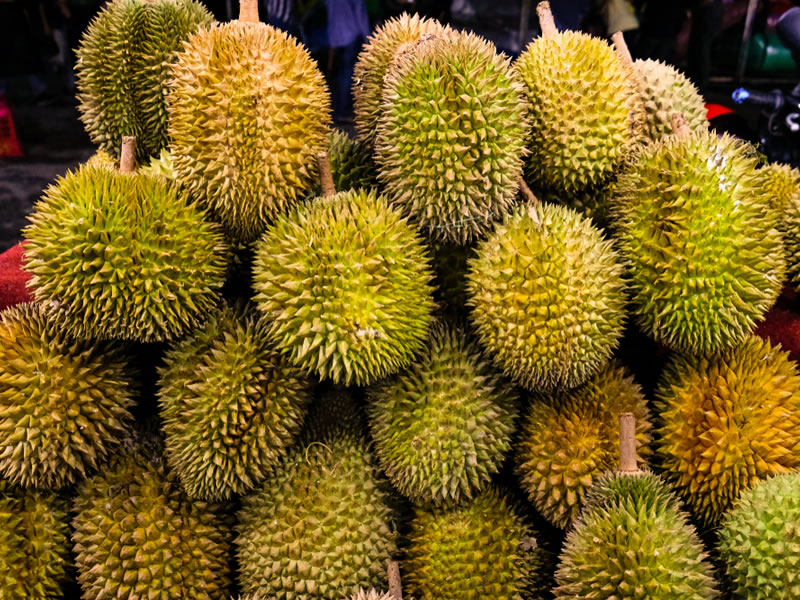 A smell that is similar to that of a cheese whose expiry date would be exceeded by several weeks ... You would want to consume such a fruit? Probably not! Yet in South-East Asia, where he is from, the durian is popular!
A smell that is similar to that of a cheese whose expiry date would be exceeded by several weeks ... You would want to consume such a fruit? Probably not! Yet in South-East Asia, where he is from, the durian is popular!
Easily available in the markets of Thailand, but also Indonesia, Malaysia or Singapore, and recognizable thanks to its ovoid shape and multiple spines, it is nevertheless not uncommon to see signs in public places specifying that the consumption of Durian is strictly forbidden, as its smell is nauseating.
With its creamy and greasy texture, the fruit is particularly acclaimed for its virtues against headaches, but also to facilitate sleep . Still, better not to abuse it: very caloric, it is also dangerous for people with sensitive intestines, as well as for pregnant women.
A sausage, curry and tomato sauce ... It's not easier! This is not haute cuisine, but in Berlin, everyone loves currywurst . If you go there, you can not also miss this very popular snack because of its quality / price ratio.
Its origin remains mysterious: no one really knows who invented it. Among the hypotheses, that of Herta Heuwer who, as early as 1949, proposed this iconic dish in its West Berlin snack bar, or the rumor that it was created with the British soldiers' sauce of tomato sauce and Worcestershire sauce. during the blockade of Berlin by Russian troops.
A veritable institution ( 800 million portions are consumed annually in Germany ), the currywurst even has its own museum in Berlin. What discover, in particular, that several songs are dedicated to him!
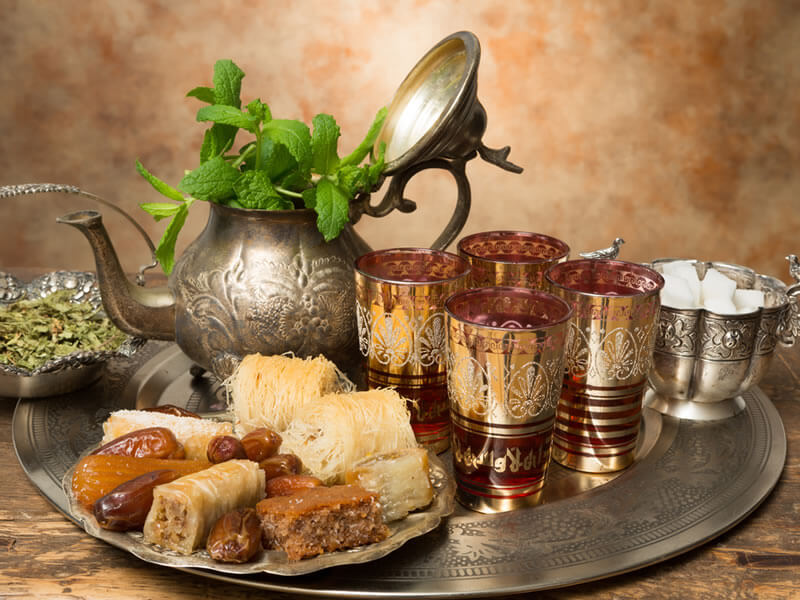 Sweet, colorful, scented ... They are a real delight, and even more divine when served with a mint tea. Composed of honey, cinnamon, orange blossom, almond ... these sweets accompany every moment of life, the most sad as the most joyful.
Sweet, colorful, scented ... They are a real delight, and even more divine when served with a mint tea. Composed of honey, cinnamon, orange blossom, almond ... these sweets accompany every moment of life, the most sad as the most joyful.
The most famous pastry undeniably remains the horn of gazelle , with its shape of small croissant, stuffed with marzipan and covered with a fine sand paste scented with orange blossom. It is part of Moroccan heritage and is popular all over the world. She was born in Fez: if you visit this city, we advise you to taste it in the Medina.
When they come out of the oven, they should be lightly browned. Too much cooked, they are then perceived as missed: in Morocco, it is even perceived as an insult to women.
In Darija, the Moroccan vocabulary, "horn of gazelle" is translated indeed by "peg of gazelle". The reason for that? Previously, Moroccan women dressed in traditional djellaba, hiding their faces and bodies to the ankles. Since it was the only part visible to men, they took great care to have them clean, smooth and white. It is therefore their ankles that the men called gazelle horns.
The most typical meal of the country, with the famous feijoada , it is consumed by all social classes. But what is churrasco ? It is simply a barbecue , which is an opportunity for Brazilian families to meet almost every Sunday. The picanha , a meat that comes from a breed of black oxen raised in the south of the country, is often the most appreciated.
The basic rule to prepare it? Use charcoal so that it has a good taste of wood. Using a churrasqueira, an electrical system, is (almost) synonymous with sin.
The pieces, seasoned with coarse salt, are very often served with a hot sauce made from red peppers, white wine, olive oil and vinegar.
In big cities, churrascarias are numerous: the waiters go around tables with huge skewers to deposit, at will, slices of meat to the guests.
Unmistakable smells and a farandole of colorful spices ... Indian cuisine undeniably makes it possible to escape! Among the dishes that are a classic in the country, the dal (or dahl ): this legume-based dish, rich in protein and vitamins, is perfect for vegetarians , who make up one-third of the Indian population.
Very often eaten with rice, it can also be with nans , a dish that is much more than a food because it is often used as a dish, in a nation where you often eat with your fingers. Generally, it is also served with a dairy called raita .
The recipe of the dal varies from one region to another, and each family has its own version, which is passed on from generation to generation.
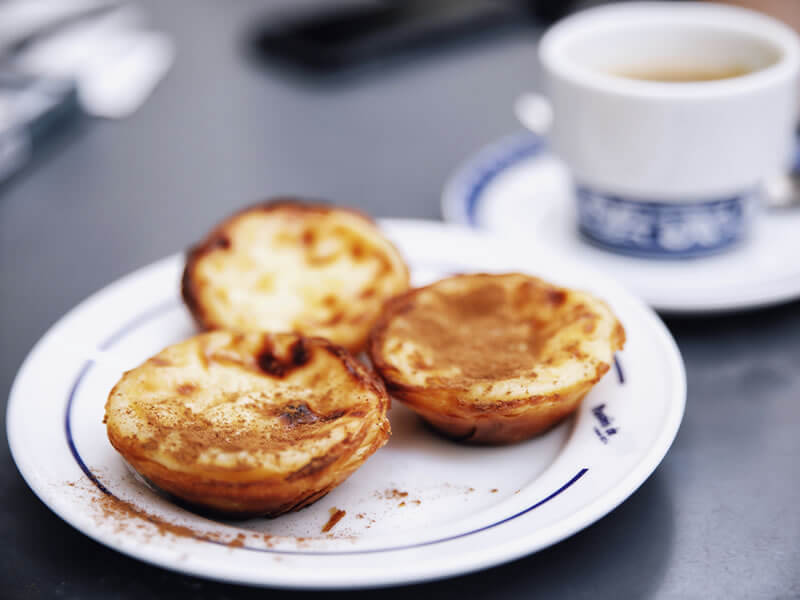 Flan coated with puff pastry, all sprinkled with cinnamon ... Appetizing, is not it? Admittedly, it's not the best if you're on a diet, but this little Portuguese pastry is worth the detour!
Flan coated with puff pastry, all sprinkled with cinnamon ... Appetizing, is not it? Admittedly, it's not the best if you're on a diet, but this little Portuguese pastry is worth the detour!
Her recipe, secretly owned, was invented by nuns : considered too sensitive to do agricultural work, they spent their day in the kitchen to, in particular, prepare many recipes based on eggs laid by their chickens.
The pastel attracts many tourists to Belém, the district of Lisbon where it was born, although today it is found in all the cafes and bakeries in the Portuguese capital, or even throughout the country.
>> This article could also interest you :9 Portuguese dishes to discover and enjoy
Composed of marinated raw fish , this dish seems simple to achieve. Nevertheless, it should not be neglected the preparation of its marinade made of lime and chicha (fermented liquid made from corn) and its seasoning, made with garlic, coriander and peppers, which bring to the palate incomparable flavors.
Generally served with avocado, sweet potatoes or corn, the origin of ceviche is controversial. Among the hypotheses related to its appearance: his name would be a declension of the Arabic word sibech, which means "acidic food".
Traditionally prepared with grouper, the dish is available at will and today, we find some with tuna or seafood . Some chefs do not hesitate to revisit its marinade, replacing the lime with grapefruit or orange. A true star in Peru, Ceviche even has its own official day, June 28, and has been a cultural heritage since 2004.
In French, this is called the guinea pig ! If it is totally unthinkable to consume in our latitudes, this is not the case in the central Andes, where his name refers to his squeak. Its taste, close to the rabbit, is appreciated by the Peruvians since they devour each year more than 60 million .
Usually abundant at major events (stew or fried), it is known to be rich in protein, and is especially less fat than chicken or pork.
The animal has other virtues since the traditional healers of Peru use it to diagnose diseases, by circulating over the person affected, before sifting the bowels of the poor beast to determine the origin difficulty.
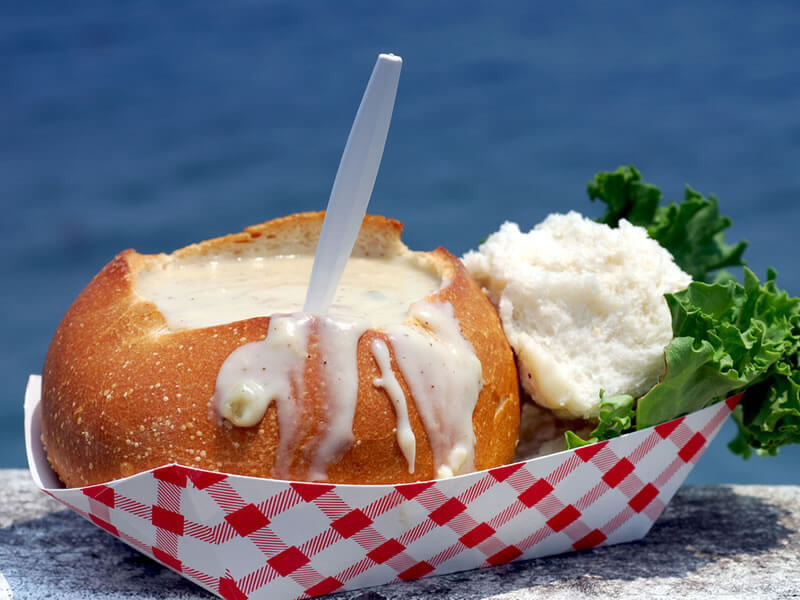 Literally, a clam chowder. This soup, which contains shellfish, potatoes, vegetable juice and cream , is also sometimes served with bacon, or tomato version, and decorated with crackers on the top.
Literally, a clam chowder. This soup, which contains shellfish, potatoes, vegetable juice and cream , is also sometimes served with bacon, or tomato version, and decorated with crackers on the top.
Originally, it was a dish for men working on boats, before becoming popular throughout the US since today, it is consumed on the east side as well as west .
The particularity of this soup is that it is often served in a bowl ... made of leavened bread! The latter, soaked in soup, is so ultra-tasty.
Jewish specialty whose origins go back to the 19 th century, it was born in Central Europe (more particularly in Romania), before being imported to the United States (and to know its hour of glory) by the Jewish migrants .
Well-stocked sandwich that can serve as a dish, it is consumed in the streets of New York but is also often found on the map delicatessen , also called deli , translated into French by "restaurant-catering".
Pastrami, a piece of smoked beef breast soaked in brine, is trapped between two slices of bread spread with mustard and traditionally served with white cabbage and pickles.
The most famous establishment to taste it? At Katz Delicatessen , in the Lower East Side neighborhood. A place made famous by the film "When Harry meets Sally", where the two characters eat ... a pastrami sandwich! The latter is worth: lines are often formed on the sidewalk to access the restaurant, and the wait can be counted in hours.
 The culinary escapade continues in the city that never sleeps, but the sweet ray this time! Place au cronut , this pastry became a real world phenomenon in 2013. On his initiative, a Frenchman, Dominique Ansel, who opened his bakery in the district of Soho two years earlier.
The culinary escapade continues in the city that never sleeps, but the sweet ray this time! Place au cronut , this pastry became a real world phenomenon in 2013. On his initiative, a Frenchman, Dominique Ansel, who opened his bakery in the district of Soho two years earlier.
Cronut is actually a culinary UFO: a puff pastry, similar to that of a French croissant, whose shape resembles that of an American donut . The whole is fried, before being stuffed with cream and adorned with a glaze. As a result, there were huge files in front of the French confectioner's establishment, people cruising for hours, and many disappointed people who had traveled hundreds of miles to get home empty-handed.
Buying a cronut is proving to be a real adventure: only 250 are manufactured per day, which is significantly lower than demand. Victim of its success, cronut even has its own black market: offered at $ 5, it can resell up to $ 40.
With this dish, it's all or nothing: we love it or we hate it! A real institution in his native country, it is composed of a mutton belly cooked in broth, containing chopped offal (heart, liver, lung) mixed with onions, spices and oatmeal . The dish is presented with a sauce made from mutton fat and oats and usually accompanied by mashed potatoes.
If the first bite can surprise, the Scots, they are crazy, even to the point of consuming it from breakfast. Regarding its origins, they remain vague. Some people think that "haggis" would be derived from the Swedish words "hagga" and Icelandic "hoggva", which means "chopped": his story could be related to the Vikings.
Completely improbable, but true, the haggis is also the star of some Scottish sports competitions . Standing on a barrel, athletes engage in a challenge to throw weight ... but replace the latter by the famous stuffed sheep body, weighing 500 grams. The current world record is held since 2011 by Lorne Coltart (19 years old at the time), with a throw at 66 meters.
Note that even vegetarians can enjoy this dish since there is a version based on lenses.